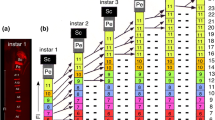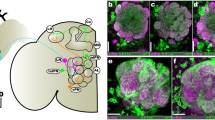Summary
During metamorphic adult development, neurons and glial cells in the developing olfactory (antennal) lobes of the moth undergo characteristic and extensive changes in shape. These changes depend on an interplay among these two cell types and ingrowing sensory axons. All of the direct cellular interactions occur against a background of changing steroid hormone titers. Antennal-lobe (AL) neurons dissociated from stage-5 (of 18 stages) metamorphosing animals survive at least 3 wk in primary cell culture. We describe here the morphological influences on AL neurons of (1) exposure to the steroid hormone 20-hydroxyecdysone, (2) exposure to sensory axons, and (3) interactions among the AL neurons. Cultured AL neurons respond only weakly, if at all, to 20-hydroxyecdysone. They do, however, show greater total outgrowth and branching when they had been exposed in vivo to sensory axons. Because there is no direct contact between some of the neuronal types and the sensory axons at the time of dissociation, the increase in outgrowth must have been mediated via a diffusible factor(s). When AL cells (neurons and glia) are plated at high density in low volumes of medium, or when the cells are plated at low density but in the presence of medium conditioned by high-density cultures, neurite outgrowth and cell survival are increased. Nerve growth factor (NGF), epidermal growth factor (EGF), fibroblast growth factor-basic (bFGF), transforming growth factor-β (TGF β ) and insulin-like growth factor (ILGF) had no obvious effect on neuronal morphology and thus are unlikely to underlie these effects. Our results suggest that the mature shape of AL neurons depends on developmental interactions among a number of diffusible factors.
Similar content being viewed by others
References
Banerjee, U.; Zipursky, S. L. The role of cell-cell interaction in the development of theDrosophila visual system. Neuron 4:177–187; 1990.
Bastiani, M. J.; Doe, C. Q.; Helfand, S. L.; Goodman, C. S. Neuronal specificity and growth cone guidance in grasshopper andDrosophila embryos. TINS 8:257–266; 1985.
Hayashi, I.; Perez-Magallanes, M.; Rossi, J. M. Neurotrophic factor-like activity inDrosophila. Biochem. Biophys. Res. Comm. 184:73–79; 1992.
Hildebrand, J. G.; Hall, L. M.; Osmond, B. C. Distribution of binding sites for125I-labeledα-bungarotoxin in normal and deafferented antennal lobes ofManduca sexta. Proc. Natl. Acad. Sci. 76:499–503; 1979.
Homberg, U.; Montague, R. A.; Hildebrand, J. G. Anatomy of the antennocerebral pathways in the brain of the sphinx mothManduca sexta. Cell. Tiss. Res. 254:255–281; 1988.
Horvitz, H. R. Neuronal cell lineages in the nematodeCaenorhabditis elagans. In: Garrod, D. and Feldman, J., eds. Development of the nervous system. Cambridge: Cambridge University Press; 1981: 331–345.
Johnson, E. M.; Rich, K. M.; Yip, H. K. The role of NGF in sensory neurons in vivo. TINS 9:33–37; 1986.
Levine, R. B.; Weeks, J. C. Reorganization of neural circuits and behavior during insect metamorphosis. In: Kelly D., Carew T., eds. Perspectives in Neural Systems and Behavior. New York: Alan R. Liss, 1989:195–228.
Malun, D.; Oland, L. A.; Tolbert, L. P. Do uniglomerular output neurons participate in forming the template for olfactory glomeruli in the moth? Soc. Neurosci. Abst. 19:443; 1993.
Matsumoto, S. G.; Hildebrand, J. G. Olfactory mechanisms in the mothManduca sexta: response characteristics and morphology of central neurons in the antennal lobes. Proc. R. Soc. Lond. B 213:249–277; 1981.
Muskavitch, M. A. T.; Hoffmann, F. M. Homologs of vertebrate growth factors inDrosophila melanogaster and other invertebrates. Curr. Topics in Devel. Biol. 24:289–328; 1990.
Oland, L. A.; Hayashi, J. H. Effect of the steroid hormone 20-hydroxyecdysone and prior sensory input on the survival and growth of moth central olfactory neurons in vitro. J. Neurobiol. 24:1170–1186; 1993.
Oland, L. A.; Oberlander, H. Growth and interactions of cells from the insect nervous system in vitro. In: Maramorosch, K.; McIntosh, A. H., eds. Insect Cell Biotechnology. 1994, in press.
Oland, L. A.; Orr, G.; Tolbert, L. P. Construction of a protoglomerular template by olfactory axons initiates the formation of olfactory glomeruli in the insect brain. J. Neurosci. 10:2096–2112; 1990.
Oland, L. A.; Tolbert, L. P. Glial patterns during early development of the antennal lobes ofManduca sexta: a comparison between normal lobes and lobes deprived of antennal axons. J. Comp. Neurol. 255:196–207; 1987.
Oland, L. A.; Tolbert, L. P. Effects of hydroxyurea parallel the effects of radiation in developing olfactory glomeruli in insects. J. Comp. Neurol. 278:377–387; 1988.
Oland, L. A.; Tolbert, L. P., Mossman, K. L. Radiation-induced reduction of the glial population during development disrupts the formation of olfactory glomeruli in the insect brain. J. Neurosci. 8:353–367; 1988.
Prugh, J.; Della Croce, K.; Levine, R. B. Effects of the steroid hormone. 20-hydroxyecdysome, on the grwoth of neurites by identified insect montoneurons in vitro. Dev. Biol. 154:331–347; 1992.
Thoenen, H.; Barde, Y.-A. Physiology of nerve growth factor. Physiol. Rev. 60:1284–1335; 1980.
Tolbert, L. P.; Sirianni, P. A. Requirement for olfactory axons in the induction and stabilization of olfactory glomeruli in an insect. J. Comp. Neurol. 298:69–82; 1990.
Truman, J. T. Hormonal approaches for studying nervous system development in insects. Adv. Insect Physiol. 21:1–34; 1988.
Warren, J. T.; Gilbert, L. I. Ecdysone metabolism and distribution during the pupal-adult development ofManduca sexta. Insect Biochem. 16:65–82; 1986.
Witten, J. L.; Levine, R. B. Cellular specificity of steroid influences on process outgrowth of identified motoneurons in culture. Soc. Neurosci. Abstr. 17:1320; 1991.
Wolff, T.; Ready, D. F. In search of a role for growth factors inDrosophila eye development. Sem. Devel. Biol. 2:305–316; 1991.
Author information
Authors and Affiliations
Rights and permissions
About this article
Cite this article
Oland, L.A., Oberlander, H. Factors that influence the development of cultured neurons from the brain of the mothManduca sexta . In Vitro Cell Dev Biol - Animal 30, 709–716 (1994). https://doi.org/10.1007/BF02631275
Received:
Accepted:
Issue Date:
DOI: https://doi.org/10.1007/BF02631275




